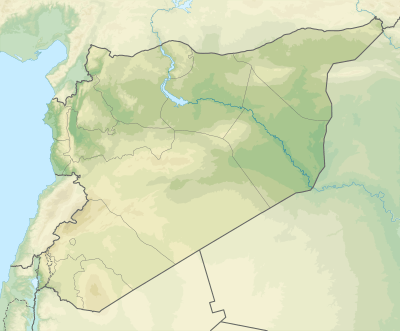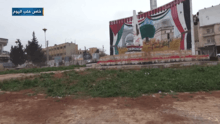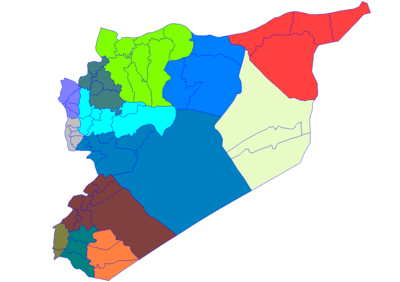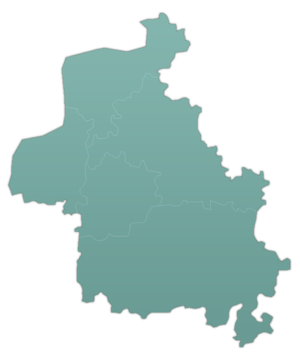Idlib
Idlib (Arabic: إدلب, also spelt Edlib or Idleb) is a city in northwestern Syria, 59 kilometers (37 mi) southwest of Aleppo, which is the capital of the Idlib Governorate. It has an elevation of nearly 500 meters (1,600 ft) above sea level. The city was taken over by Syrian rebel militias at the beginning of the Syrian Civil War in 2011, and by 2017 was the seat of the Syrian Salvation Government.
Idlib إدلب | |
|---|---|
 Typical grove in one of the valleys surrounding Idlib. | |
 Idlib Location of Idlib within Syria | |
| Coordinates: 35°56′N 36°38′E | |
| Country | |
| Governorate | Idlib |
| District | Idlib |
| Subdistrict | Idlib |
| Control | |
| Government | |
| • Governor | Atef Ghanem al-Naddaf |
| Elevation | 500 m (1,600 ft) |
| Population (2010 census[1]) | |
| • Total | 165,000 |
| Demonym(s) | Arabic: إدلبي, romanized: Idlibi |
| Area code(s) | 23 |
| Geocode | C3871 |
| Climate | Csa |
| Website | eIdleb |
In the 2004 census by the Central Bureau of Statistics, Idlib had a population of 98,791 and in 2010 the population was around 165,000. Before the civil war, the inhabitants had mostly been Sunni Muslims,[2] although there was a significant Christian minority. Idlib is divided into six main districts: Ashrafiyeh (the most populous), Hittin, Hejaz, Downtown, Hurriya, and al-Qusur.
A major agricultural center of Syria, the Idlib area is also historically significant, containing many "dead cities" and tells.
History
Classical Antiquity
Idlib, along with the rest of Syria were conquered by the Armenian king Tigranes the Great, and incorporated in the Armenian Empire, only to be later conquered by the Roman Pompey the Great around 64 BC. The city was never of much significance, belonging to the province of Roman Syria under the Roman Empire, and later to the Eastern Roman province of Syria Secunda before being conquered by the Arabs around the middle of the seventh century. Not much remains from Roman and Byzantine times in the city, except in its museum. North of the city are the Dead Cities, a collection of important archaeological sites from the Byzantine era.
Ottoman era
During Ottoman rule in Syria, between the 16th and 19th centuries, Idlib served as the capital of a kada ("subdistrict capital") bearing its name, part of the larger Vilayet of Aleppo ("Province of Aleppo.")[4] The city was a center of olive production during the reign of Grand Vizier Köprülü Mehmed Pasha,[5] which in turn gave way to a prosperous olive-based soap industry. Although the major markets for Idlib's soap were at Aleppo, Antioch, and Hama,[6] the product was exported as far as the Ottoman capital of Istanbul. Idlib was also a major producer of cotton fabrics.[7] Western traveler Josias Leslie Porter noted that Idlib was "encompassed in olive groves, rare in this bleak region",[6] and remarked that its olive groves were larger than those of Damascus, Beirut, or Gaza. In the mid-19th-century, the town had an estimated population of 8,000, including 500 Christians.[6] In the late 19th century, Idlib was "flourishing" and still contained a number of Christian families, according to German orientalist Albert Socin.[4]
Syrian Civil War

During the uprising since 2011, Idlib was the focus of protests and fighting in the early phase of the Syrian war. As the uprising descended into armed conflict, Idlib became the focus of a rebel campaign, which temporarily captured the city and the governorate, prior to a government offensive in April 2012. After this, government forces retook the city and the rebel-controlled province after a month of fighting, prior to the attempted enforcement of the ceasefire proposed by Kofi Annan. After the 2015 Idlib offensive in March, the rebel alliance Army of Conquest, led by the al-Nusra Front and Ahrar al-Sham, succeeded in the Second Battle of Idlib and captured the city,[8] as well as besieging the Shi'a-majority towns of Al-Fu'ah and Kafriya to the north of Idlib city.[9] In April 2015, the interim seat of the Syrian opposition's Syrian Interim Government was proposed to be Idlib,[10] in Idlib Governorate. On 23 July 2017, Tahrir al-Sham, successor of the al-Nusra Front, expelled the remaining forces of Ahrar al-Sham from Idlib, capturing the entire city.
Climate
Köppen-Geiger climate classification system classifies its climate as hot-summer Mediterranean (Csa).[11] Summers are hot and rainless, while winters are rainy and cool.
The all-time record high temperature was 44 °C (111 °F) on June 16, 2012.[12]
| Climate data for Idlib | |||||||||||||
|---|---|---|---|---|---|---|---|---|---|---|---|---|---|
| Month | Jan | Feb | Mar | Apr | May | Jun | Jul | Aug | Sep | Oct | Nov | Dec | Year |
| Record high °C (°F) | 20 (68) |
21 (70) |
26 (79) |
35 (95) |
37 (99) |
44 (111) |
42 (108) |
39 (102) |
38 (100) |
37 (99) |
29 (84) |
24 (75) |
44 (111) |
| Average high °C (°F) | 9.9 (49.8) |
12.2 (54.0) |
16.7 (62.1) |
22.2 (72.0) |
28.0 (82.4) |
31.7 (89.1) |
33.2 (91.8) |
34.2 (93.6) |
31.8 (89.2) |
26.7 (80.1) |
18.7 (65.7) |
12.2 (54.0) |
23.1 (73.7) |
| Daily mean °C (°F) | 6.2 (43.2) |
7.7 (45.9) |
11.3 (52.3) |
15.8 (60.4) |
20.9 (69.6) |
25.0 (77.0) |
27.5 (81.5) |
27.8 (82.0) |
25.1 (77.2) |
20.0 (68.0) |
13.0 (55.4) |
8.1 (46.6) |
17.4 (63.3) |
| Average low °C (°F) | 2.5 (36.5) |
3.2 (37.8) |
6.0 (42.8) |
9.5 (49.1) |
13.8 (56.8) |
18.4 (65.1) |
21.0 (69.8) |
21.4 (70.5) |
18.4 (65.1) |
13.4 (56.1) |
7.4 (45.3) |
4.0 (39.2) |
11.6 (52.8) |
| Record low °C (°F) | −5 (23) |
−5 (23) |
1 (34) |
1 (34) |
8 (46) |
15 (59) |
18 (64) |
20 (68) |
13 (55) |
3 (37) |
−4 (25) |
−5 (23) |
−5 (23) |
| Average precipitation mm (inches) | 97 (3.8) |
88 (3.5) |
59 (2.3) |
41 (1.6) |
18 (0.7) |
5 (0.2) |
0 (0) |
0 (0) |
6 (0.2) |
25 (1.0) |
41 (1.6) |
93 (3.7) |
473 (18.6) |
| Source 1: Climate-Data.org (altitude: 432m)[11] | |||||||||||||
| Source 2: Voodoo Skies for record temperatures[12] | |||||||||||||
Economy

Idlib is a major production center for olives, cotton, wheat and fruits, particularly cherries.[13] Other principal crops include almonds, sesame seeds, figs, grapes and tomatoes.[14] In 1995 there were roughly 300 hectares planted with various citrus crop.[15] Olive oil pressing and textiles are some of the city's local industries.[14] The nearby city of Aleppo has an important economic presence in Idlib.[13]
The Idlib Regional Museum in the city contains over 17,000 of the Ebla tablets and serves as Idlib's main tourist attraction, excluding the nearby ancient site of Ebla itself. Under the Technical and Financial Cooperation Agreement between the governments of Italy and Syria, the museum was to undergo a restoration and renovation project starting in 2010.[16]
Because of the rapidly declining value of the Syrian pound, the Turkish lira became widespread in use in Idlib and was adopted as legal tender in the city on 15 June 2020.[17]
Sports
Omayya SC, founded in 1972, is the most popular football team in the city. The club played in the Syrian Premier League for the 2011-2012 season. Idlib Municipal Stadium is the main football venue in the city.
References
- "مدينة إدلب السورية". aljazeera.net. Archived from the original on 2014-10-17. Retrieved 2014-10-16.
- Mroue, Bassem. "Syrian forces capture rebel stronghold near Turkey" Archived 2013-09-23 at the Wayback Machine. The Salt Lake Tribune. Associated Press. 2012-03-13. Retrieved on 2012-03-13.
- Timothy P. Harrison, Edward B. Banning. Walls of the Prince: Egyptian Interactions with Southwest Asia in Antiquity: Essays in Honour of John S. Holladay, Jr. p. 76. Archived from the original on 2016-06-10. Retrieved 2016-05-20.
- Baedeker, 1912, p.376.
- "İdlib, meşhur sadrazam Köprülü Mehmed Paşa'nın en büyük vakıflarından birinin merkezi idi". haberturk.com (in Turkish). 9 September 2018.
- Porter, 1868, p. 580.
- Inalcik, 1997, p.501.
- "Gulf allies and 'Army of Conquest". Al-Ahram Weekly. 28 May 2015. Archived from the original on 31 May 2017. Retrieved 4 September 2018.
- Sherlock, Ruth (29 March 2015). "Thousands flee Syrian city Idlib after rebel capture". The Telegraph. Archived from the original on 29 March 2015. Retrieved 29 March 2015.
- "Will Syrian opposition move interim government to Idlib? - Al-Monitor: the Pulse of the Middle East". Al-Monitor. Archived from the original on 2016-12-26. Retrieved 2016-12-13.
- "Climate: Idlib - Climate graph, Temperature graph, Climate table". Climate-Data.org. Archived from the original on 2013-12-05. Retrieved 2013-12-03.
- "Idlib, Syria". Voodoo Skies. Archived from the original on 2016-03-21. Retrieved 2013-12-03.
- Casule, 2008, p.56.
- Idlib, Syria Archived 2012-03-11 at the Wayback Machine. Encyclopædia Britannica. Encyclopædia Britannica Inc. 2012. Retrieved on 2012-03-11.
- Food and Agriculture Organization of the United Nations, 1996, p. 147.
- Ferrari, 2009, p. 522.
- DAILY SABAH WITH AGENCIES (2020-06-16). "Idlib follows suit in adopting Turkish lira to shield region from plummeting Syrian pound". Daily Sabah. Retrieved 2020-06-16.
Bibliography
- Baedeker, Karl (1912), Palestine and Syria, with routes through Mesopotamia and Babylonia and the island of Cyprus: handbook for travellers, K. Baedeker
- Casule, F. (2008), Art and History Syria, Casa Editrice Bonechi, ISBN 8847601193
- Angelo, Ferrari (2009), Proceedings 4th International Congress on "Science and Technology for the Safeguard of Cultural Heritage in the Mediterranean Basin", 1, Angelo Ferrari-CNR, Institute of Chemical Methodologies, ISBN 889668031X
- Food and Agriculture Organization of the United Nations (1996). Citrus Pest Problems and Their Control in the Near East. Food & Agriculture Org. ISBN 9251033013.
- Inalcik, Halil (1997), An Economic and Social History of the Ottoman Empire, Cambridge University Press, ISBN 0521574552
- Porter, Josias Leslie (1858). A Handbook for Travellers in Syria and Palestine. 1. Murray.
External links
News and events
- eIdleb The first complete website for Idleb news and services
_Syria.jpg)

